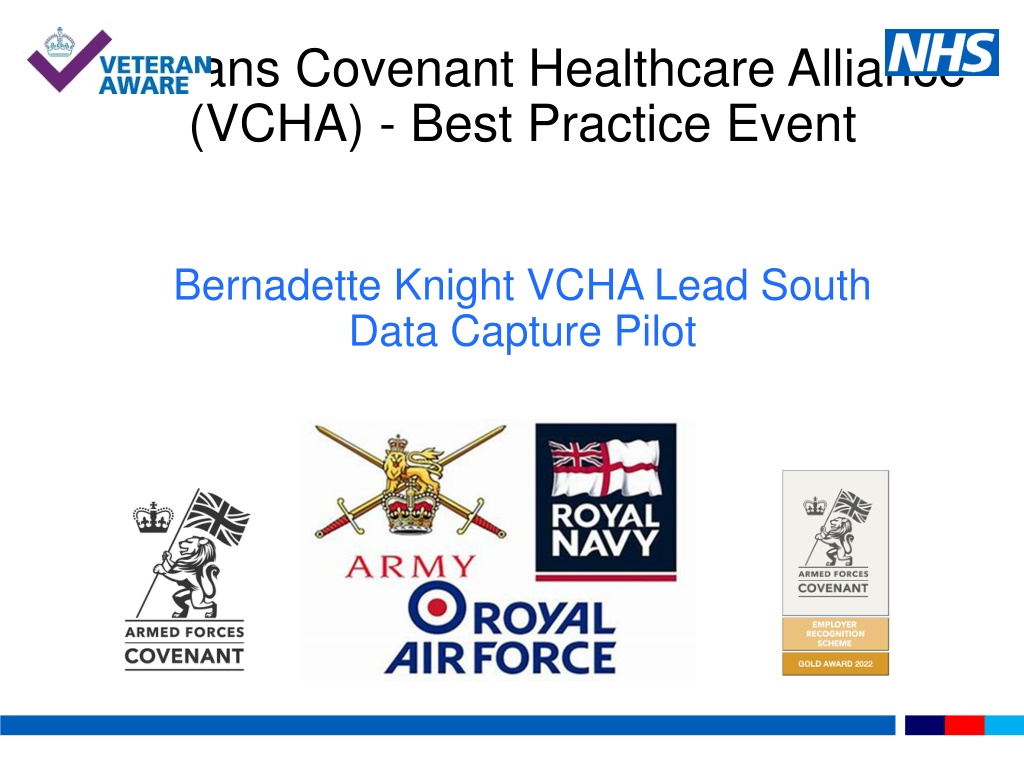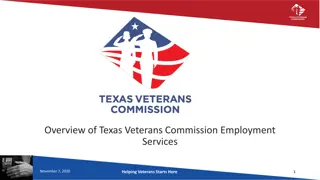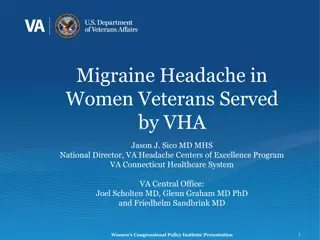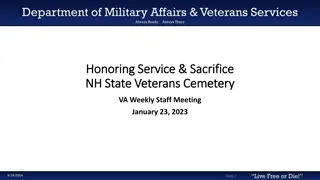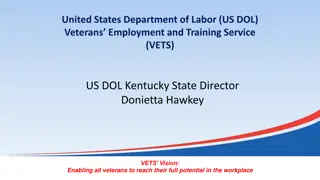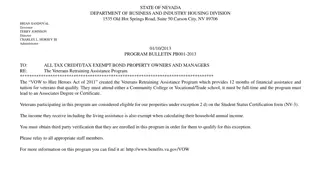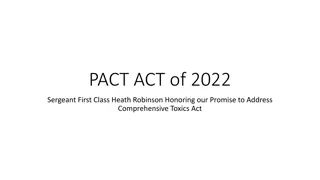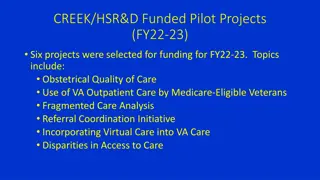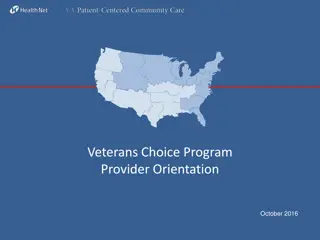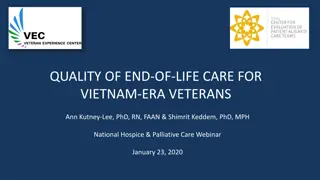Veterans Covenant Healthcare Alliance (VCHA) Initiative Overview
The Veterans Covenant Healthcare Alliance (VCHA) is collaborating with the Defence Medical Welfare Service (DMWS) to improve healthcare access and outcomes for the armed forces community. The initiative aims to establish a core reporting dataset, reduce variation, and enhance service quality in line with the Armed Forces Covenant. Demographic data highlights the significance of this population, and the pilot project involves multiple sites for data collection and analysis over a six-month period.
Download Presentation

Please find below an Image/Link to download the presentation.
The content on the website is provided AS IS for your information and personal use only. It may not be sold, licensed, or shared on other websites without obtaining consent from the author. Download presentation by click this link. If you encounter any issues during the download, it is possible that the publisher has removed the file from their server.
E N D
Presentation Transcript
Veterans Covenant Healthcare Alliance (VCHA) - Best Practice Event Bernadette Knight VCHA Lead South Data Capture Pilot
Scope Introduction progress, momentum Context next phase Vision and aim Current update on pilot framework Dashboard Next Steps What does BaU look like? End State
Introduction It is widely accepted that there is currently a wide range of data sources relating to armed forces healthcare which can be confusing. However, there is no definitive, standard, validated source easily accessible to commissioners and providers to support oversight, assurance, planning and improvements at local and national levels. The formation of an alliance between the VCHA and the DMWS will ensure delivery of the aims of both organisations which are to improve healthcare access and outcomes (in line with the Armed Forces Covenant) for the armed forces community by developing, sharing and driving the implementation of best practice that will improve care, whilst at the same time also raising standards across the NHS for all users. 3
Context Demographic data indicates that England has a significant Veteran and Armed Forces population 1 in 25 according to the results of the Census 2021. Our view is that more can be done to increase collaboration and coding for this population to support greater understanding and service improvement in line with the Armed Forces Covenant and NHS long term aims. The challenge is to identify the required core dataset and find the most effective way to use that data to drive optimum delivery and operational efficiency. The opportunity to combine quantitative data with outcome data will deliver a reliable measure of impact on patient experience.
Vision and Aim To identify and establish a national, universal, core reporting dataset, demonstrating impact and effect for individuals, providers and commissioning organisations to support sustainability To identify and establish the most effective model to deliver the requirements of the Armed Forces Covenant (AFC), reducing variation and improving access and outcomes To evaluate the value of the combined impact that the two organisations have on the final experience of a service user.
Pilot status 8 (10) diverse pilot sites Professional analytics support Data collection over 6 month period April September 2023 Standard dataset quantitative and qualitative measures Mid way review July 2023 Final report with recommendations early 2024 All sites and partners engaged, some sites more challenged by this than others Currently on track Plan (Apr 24 onwards) 6
Dataset 1 Quantitative data to be reported by each trust: Numbers of service users flagged as armed forces status (veteran, reservist, spouse/family, serving) Gender Age range Which service army/navy/RAF Referral route Admission type Contact type in person, virtual, phone Issue and complexity Numbers of onward referrals 7
Dataset 2 Qualitative/Outcome measures: Improved condition Improved patient experience Reduced MH crisis Reduced delayed transfers of care Reduced readmissions Reduced frequent attenders Reduced DNAs Obtained 3rd party support reducing need for NHS services Reduced staff sickness 8
Pilot sites Ser Trust Region Rehab DMWS VCHA AFA Op RESTORE East Lancs NW x x x 1 James Paget East of England x x 2 Salisbury SW x X x x 3 Queen Elizabeth Hospital Kings Lynn East of England X x 4 Plymouth SW x x x 5 6 Great Western Hospital SW X X X Royal London London x 7 Shrewsbury West Midlands x 8 Surrey and Sussex (SASH) SE x 9 10 VCHA National N/A 11 DMWS National N/A 12 Edge Health National N/A
Dashboard Structure The dashboard displays both quantitative and qualitative data. Quantitative data is collected from Trust-level Hospital Episode Statistics (HES) data submitted by individual trusts on care accessed across: Emergency care Inpatient care Outpatient care Qualitative data (DMWS data) is collected through qualitative patient surveys by DMWS officers.
Dashboard tools Dashboard provides charts summarising data for users to view and interact with data using tabs selectors, trust filter and date range selectors. Date range selectors Tab selector Trust filter
Emergency department dashboard Trust 1
Comparison of trust volumes and wait times Trust 1 Trust 2
Comparison of demographics Age distribution of Emergency Department attendances Trust 1 Age distribution of Emergency Department attendances Trust 2
Comparison of arrival by ambulance Proportion of ED attendances that arrived by ambulance
Comparison of outcome of ED attendance Outcome of ED attendance Outcome of ED attendance
Comparison of length of stay Length of stay for emergency inpatient admissions 8.5 day(s)
Comparison of inpatient admissions admitted through ED Proportion of inpatient admissions admitted through ED
Patient experience page Top 10 issues with major impact Top 10 issues with major impact on patients (all trusts combined) Sports activities Falls Living barriers Health treatments Frailty Family issues Disability General health Mental health Social isolation Mean impact score
Patient experience page Outcomes post-referral Top 5 outcomes post-referral for patients (all trusts combined) Top 5 outcomes post-referral for patients (all trusts combined) Top 5 outcomes post-referral for patients (all trusts combined) Improved access to support Improved access to support Improved access to support Improved access to support Improved healthcare Reduced social isolation Improved healthcare Improved healthcare Improved healthcare Reduced health stress Reduced social isolation Reduced social isolation Reduced social isolation Access to home Percentage Reduced health stress Reduced health stress Reduced health stress Accessed home Accessed home Accessed home Percentage Percentage Percentage
Patient experience page Trust-specific comparison
Next Steps ID core data set Upscale Widen scope Identification of unwarranted variation Pilot onsite visits by experts (GIRFT style nuanced focus) Make recommendations
What does BaU look like? All providers submitting core data set (to agreed platform) Query linked via model hospital Use of data to monitor reports and assure (and act upon) Establishing sustained and continuous improvement Patient experience
End-state Delivering a national, universal, core reporting dataset Demonstrate impact/Measurement of effect (soft and hard) Continuous improvement and quality performance Drive down unwarranted variation and disadvantage Early assessment needs/improvement in health and well being Wider utility (across the NHS and beyond) Financial savings Sustainability of the VCHA programme Delivering on the requirements of the AF Covenant Due Diligence
